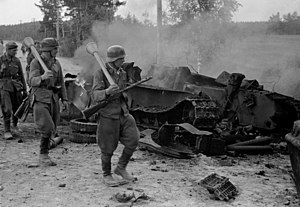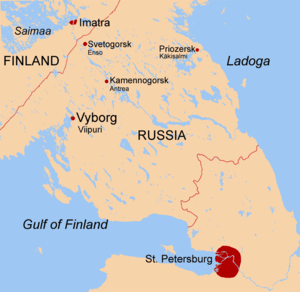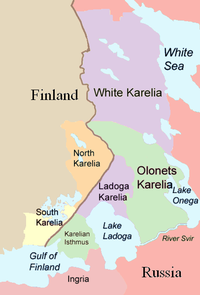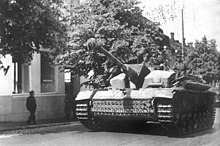Battle of Tali–Ihantala: Difference between revisions
mNo edit summary |
irrelevant picture from 1943 |
||
| Line 99: | Line 99: | ||
==Tali: June 25-June 30== |
==Tali: June 25-June 30== |
||
[[File:Destroyed Soviet tank in the Battle of Tali-Ihantala July 1944.jpg|thumb|Destroyed Soviet tank in the Battle of Tali-Ihantala July 1944]] |
[[File:Destroyed Soviet tank in the Battle of Tali-Ihantala July 1944.jpg|thumb|Destroyed Soviet tank in the Battle of Tali-Ihantala July 1944]] |
||
[[File:Destroyed IS-152.jpg|thumb|Destroyed Soviet IS-152 in front of Finnish soldiers with panzerfaust at Ihantala]][[File:PST-tykki Kannaksella.jpg|thumb|Finnish AT-gun in action |
[[File:Destroyed IS-152.jpg|thumb|Destroyed Soviet IS-152 in front of Finnish soldiers with panzerfaust at Ihantala]][[File:PST-tykki Kannaksella.jpg|thumb|Finnish AT-gun in action]] |
||
[[Image:Panzerfaust6.jpg|thumb|Finnish soldiers in a [[foxhole]]. One of the soldiers is holding a [[Panzerfaust]]]] |
[[Image:Panzerfaust6.jpg|thumb|Finnish soldiers in a [[foxhole]]. One of the soldiers is holding a [[Panzerfaust]]]] |
||
[[File:Is-2.23.JPG|thumb|Soviet heavy tanks and assultguns destroyed at Ihantala]] [[File:Is-2.4.JPG|thumb|Knockedout Soviet IS-2 at Ihantala]] [[File:Is-2.22.JPG|thumb|Sevral destroyed Soviet tanks at Ihantala, in the foreground lays two tankturent from t-34/76]][[File:Is-2.1.JPG|thumb|Another destroyed IS-2 at Ihantala]] |
[[File:Is-2.23.JPG|thumb|Soviet heavy tanks and assultguns destroyed at Ihantala]] [[File:Is-2.4.JPG|thumb|Knockedout Soviet IS-2 at Ihantala]] [[File:Is-2.22.JPG|thumb|Sevral destroyed Soviet tanks at Ihantala, in the foreground lays two tankturent from t-34/76]][[File:Is-2.1.JPG|thumb|Another destroyed IS-2 at Ihantala]] |
||
Revision as of 20:56, 24 July 2010
| Battle of Tali-Ihantala | |||||||
|---|---|---|---|---|---|---|---|
| Part of the Continuation War | |||||||
 Finnish soldiers marching next to a destroyed Soviet T-34 tank | |||||||
| |||||||
| Belligerents | |||||||
|
|
| ||||||
| Commanders and leaders | |||||||
|
Karl Lennart Oesch Kurt Kuhlmey | Dmitrii N. Gusev | ||||||
| Strength | |||||||
| 50,000 [5] | 150 000[6][7] - 150,000 [5] | ||||||
| Casualties and losses | |||||||
|
1,100 killed 1,100 missing 6,300 wounded[5] |
estimated 4,500–5,500 killed 13,500–14,500 wounded[8][9] 300+ tanks 120-280 aircraft | ||||||


The Battle of Tali-Ihantala (June 25 to July 9, 1944) was part of the Continuation War (1941–1944), which occurred during World War II. The battle was fought between the Finnish—supported by forces of Germany—and the Soviet forces. To date, it is the largest battle in the history of the Nordic countries.
The battle ended in a Finnish victory. After the battle, the Soviet Leningrad front has started previously planned[10][11] transfer of troops from the Karelian Isthmus to the Baltics.[12][13][14][15]
Background
After the initial Finnish advance of 1941, the Continuation War was stabilized to trench warfare with very little activity on either side. When the Siege of Leningrad was lifted in January 1944, the Stavka received orders to plan an offensive against Finland to push it out of the war.
The Soviet attack on the Finnish front commenced on the Karelian Isthmus on June 9, 1944, (coordinated with the Allied Invasion of Normandy). Three armies were pitted there against the Finns, among them several experienced Guard formations.[5]
The attack soon breached the Finnish front line of defence in Valkeasaari on June 10 and the Finnish forces retreated to their secondary defence line, the VT-line (which ran between Vammelsuu and Taipale). The Soviet attack was supported by a massive artillery barrage, air bombardments and armoured forces.[5]
The VT-line was breached in Sahakylä and Kuuterselkä on June 14 and after a failed counterattack in Kuuterselkä by the Finnish armoured division the Finnish defence had to be pulled back to the VKT-line (Viipuri (sw/eng: Viborg, ru: Vyborg) - Kuparsaari - Taipale).[5]
The abandonment of the VT-line was followed by a week of retreat and delaying battles. The Soviet offensive was crowned when the city of Viipuri (sw/eng: Viborg, ru:Vyborg) was captured by the Soviets on June 20 with only a short battle. Despite the Red Army’s great success in smashing two Finnish defense lines and capturing of territory in just 10 days, it had failed to destroy the Finnish army which could concentrate on the VKT-line.[5]
Mannerheim, the Finnish C-in-C, had asked for German help on June 12, and on June 16 the Flight detachment Kuhlmey arrived in Finland. A few days later the battalion-sized 303. Assault Gun Brigade and the 122nd Division Greif had also arrived but after that the Germans offered only supplies, among which Panzerfaust anti-tank weapons were the most important.[5]
The German Foreign Minister Ribbentrop arrived on June 22 and demanded a guarantee that Finland would fight to the end as a precondition of continued German military support. President Ryti gave this guarantee as a personal undertaking.
On June 22, during Ribbentrop's visit in Helsinki, the Finnish government asked for possibility of the peace and accompanied conditions from the Soviet Union. Soviet response arrived on the next day and it demanded Finnish capitulation before any conditions could be presented. This created confusion in the Finnish government, where Ryti and Tanner were willing to repeat the inquiry about the conditions, while others opposed the capitulation. During the meeting marshal Mannerheim was called, and he stated that Soviet demand constitued an unconditional surrender. When Paasikivi's negotiation trip to Moscow at March 1944, which was initiated from Soviet ambassador in Stockholm, Mrs Kollontai, but which turned out to be Soviet dictation of terms, was remembered, the government decided to interpret Soviet response as it was written: A demand for unconditional surrender. The Soviet authorities denied this interpretation in an article published in Pravda on July 2, 1944.[16][17], but at October 1993 the draft document was found in Russian foreign ministry archives with a letter dated June 28, 1944, which contained detailed conditions of Finnish surrender, being extremely close to unconditional surrender.[18]
On June 21 Stavka ordered the Leningrad Front to breach the VKT-line at Tali (Paltsevo), and to advance to Lake Saimaa.
Order of battle
Finnish
HQ of the Commander of the Isthmus Forces (Lt. Gen. Karl Lennart Oesch)
- Finnish IV AK (Lt. Gen. Taavetti Laatikainen)
- 3rd Brigade "Blue Brigade" (Col. Lauri Haanterä)
- Finnish 3rd Division (Mj. Gen. Aaro Pajari)
- Finnish 4th Division (Mj. Gen. Pietari Autti)
- Finnish 18th Division (Mj. Gen. Paavo Paalu sacked June 26, Col. Otto Snellman),
- since June 27 11th Division (Mj. Gen. Kaarlo Heiskanen).
- Finnish 6th Division (Mj. Gen. Einar Vihma)
- Finnish Armoured Division (MJ. Gen. Ruben Lagus)
- LeR 3 (Lt. Col E. Magnusson) (33 Messerschmitt Bf 109, 18 Brewster Buffalo 239 Fighters and 1 Fokker C.X reconnaissance)
- LeR 4 (Col. O. Sarko) (33 Bristol Blenheim, 12 Junkers Ju 88, 8 Dornier Do 17Z bombers)
German
- German air unit Gefechtsverband Kuhlmey (Lt. Col. Kurt Kuhlmey) arrived in Finland on June 16. (23-43 Fw-190 A-6/F-8 fighters and ground attack aircraft, 24-30 Ju-87 D Stukas and 1-8 Bf-109 G-8 reconnaissance fighters)
- German Sturmgeschütz-Brigade 303 (Cpt. Hans-Wilhelm Cardeneo) arrived in Finland on June 22. (22 StuG III Ausf. G assault guns, 9 StuH 42 assault howitzers)
Soviet
Leningrad Front (Marshall Leonid Govorov)
- Soviet 21st Army (Col. Gen Dmitrii N. Gusev) (15 divisions)
- 45 Gd division
- 63 Gd Division
- 64 Gd Division
- 178 Division
- 314Division
- 358 Division
- 372 Division
- 108 Division
- 72 Division
- 109 Division
- 286 Division
The terrain
The Battle of Tali-Ihantala was fought in a small area (100 km²) between the northern tip of Bay of Viipuri and the River Vuoksi around the villages of Tali and Ihantala, 8–14 km north-east from Vyborg.
The Soviet forces were concentrated on the area east of the city of Viipuri (Vyborg), from where the attack started through the southern village of Tali to northwards to Ihantala (Petrovka). This was the only suitable exit terrain for armoured forces out from the Karelian Isthmus, 10 km wide, broken by small lakes and limited by Saimaa Canal on the west and the River Vuoksi on the east.
Tali: June 25-June 30




The fighting in the area began on June 20.
June 20 - June 24
The first days were a defensive battle that the Finnish 18th division (Finnish 6th and 48th regiment and 28 independent battalion) and 3rd brigade (4 battalions) and the 3rd battalion of the 13 Regiment (Swedish speaking) fought against the Soviet 97th and 109th army corps and 152nd tank brigade. The defenders were hit especially hard by artillery and air attacks, but managed to put up a strong defense that stalled the Soviet advance long enough for Finnish reinforcements to join the battle.[5]
June 25 - June 26
The action of 25 June started at 0630 with a one-hour heavy artillery bombardment and air attack, followed by a major Soviet offensive from Tali village at 0730. The goal of the attack was to reach Imatra-Lappeenranta-Suurpäälä before 28 June. The 30th Soviet Guards Army corps had now also joined the battle. The Soviet army tried a breakthrough along both sides of the Lake Leitimojärvi. The attack on the eastern side of the lake was stopped after 3 kilometers by the Finnish 4th Division. On the west side the Soviet infantry of the 45th guards division and the 109th Army Corps got stuck in defensive positions around the hills of Konkkalanvuoret defended by the Finnish regiment JR48. However, Soviet tanks from the 27th Tank Regiment were able to force their way to the Portinhoikka crossroads. The Soviets also attacked with the 178th Division over the Saarela strait who was defended by 1st battalion of the Finnish regiment JR6 but the attack was thrown back here as well. Meanwhile, the 97th army corps attacked the 3rd brigade’s positions but got little ground. At this stage the situation was very critical for the Finns whose units were at risk of being cut off and surrounded. This would inevitably have led to defeat of the Finnish 4th army corps and the loss of the VKT line. The Finnish were able to organize a counterattack with the reserves of the 18th division, parts of the 17th Division and some battle groups from the 4th Division. Later on the afternoon the Finnish armored division joined the battle and managed to push the Soviet attackers on the west side of the Lake Leitimojärvi back to their starting point. The Soviet 27th Tank Regiment was annihilated apart from 6 tanks that were captured by the Finns.
June 27 - June 30
More Finnish units joined the battle along with the German 303rd Sturmgeschütz brigade. The Finnish units had been spread out and mixed in the battle, which made the organisation of a concentrated defence difficult. The Finnish units were therefore reorganised into two battle groups, BG Björkman and BG Puroma. The Soviets also reinforced their forces with the 108th Army Corps. At this stage the Soviet forces included at least 1 armored brigade, 2 armored breakthrough regiments and 4 assault gun regiments. The Finns tried to regain the initiative by attacking the 4 Soviet divisions (46th Guard, 63rd Guard, 64th Guard, 268 division and the 30 guard tank brigade) - who had broken through east of Leitimojärvi - from three directions in order to make a "motti" of the Soviet divisions. The two battle groups, Björkman and Puroma, did manage to advance to within 1 kilometer of each other but failed to surround the Soviet divisions who had set themselves up into a hedgehog defense around Talinmylly. The Finnish attack failed because of heavy Soviet resistance especially with massed tanks and artillery and because the communication between several of the battalions broke down during the attack. Colonel Puroma said after the war that the one thing he regretted was the failure to make a motti out of Talinmylly. The attack gave the Finnish defenders 72 hours of respite at the same time as the fresh Finnish 6th and 11th divisions reached the battlefield. Several tank battles took place during this fighting. On the 28th of June, the Air activity was high on both side as Finnish bombers and German Stukas pounded Soviet formations. The Soviet Air Force also attacked from the air and hit the staff of the Finnish armored division hard with bombers from the 276th Soviet bomber division. On June 28 the Finnish commander Oesch gave the order that the Finnish units should withdraw back to the line of Vakkila-Ihantalajärvi-Kokkoselkä-Noskuanselkä (still within the VKT line), but they became caught up in a new Soviet offensive. June 29 was the hardest and the worst day for the Finns during the whole battle, and defeat was not far off. The Finnish forces finally managed to restore the line on June 29 after very bloody fighting.[5]
On June 30 the Finnish forces retreated from Tali. The heaviest fighting took place between July 1 and July 2 when the Finns lost some 800 men per day.[5]
Ihantala: July 1-July 9
The ensuing Finnish concentration of artillery fire was the heaviest in the country's military history[19]. It was based on the famed fire correction method of a Finnish Artillery General Vilho Petter Nenonen which enabled easy fire correction and quick changes of targets[5]. At the critical Ihantala sector of the battle the Finnish defenders managed to concentrate their fire to the extent of smashing the advancing Soviet spearhead[19]. The clever fire control system enabled as many as 21 batteries, totaling some 250 guns, firing at the same target simultaneously in the battle; the fire controller did not need to be aware of the location of individual batteries to guide their fire, which made quick fire concentration and target switching possible. This concentration was considered a world record at the time.[5]
According to Bitva za Leningrad 1941-1944 ("The Battle of Leningrad") edited by Lieutenant General S.P. Platonov:
"The repeated offensive attempts by the Soviet Forces failed ... to gain results. The enemy succeeded in significantly tightening its ranks in this area and repulse all attacks of our troops ... During the offensive operations lasting over three weeks, from June 21 to mid-July, the forces of the right flank of the Leningrad front failed to carry out the tasks assigned to them on the orders of the Supreme Command issued on June 21."
By this time the Finnish army had concentrated half of its artillery in the area, along with the army's only armoured division, with StuG III assault guns as its primary weapon and German 303. Sturmgeschütz Brigade. The defenders now finally had the new German anti-tank weapons that were previously kept in storage.
On July 2 the Finns intercepted a radio message, according to which the Soviet 63rd Division and 30th Armored Brigade were to launch an attack on July 3 at 04:00 hours. The following morning, two minutes before the supposed attack, 40 Finnish and 40 German bombers bombed the Soviet troops, and 250 guns fired total of 4,000 artillery shells into the area of the Soviets. On the same day, beginning at 06:00, 200 Soviet planes and their infantry attacked against the Finnish troops. By 19:00 the Finnish troops had restored their lines.[5]
On July 6 the Soviet forces had some success, despite the Finnish 6th Division having 18 artillery battalions and one heavy battery for their defence. However, the Soviets were thrown back on the following day, and their counterattacks at 13:30 and 19:00 that day did not amount to anything. By July 7 the focus of the Soviet attacks was already moving to the area of Vuoksi and the Soviets now began transferring their best troops to Estonia, to fight the Germans. From July 9, the Soviet troops no longer attempted a break-through. Nevertheless, some fighting continued.[5]
Losses
Finnish sources estimate that Soviet army lost about 300 tanks in the Tali-Ihantala[5], mainly to air attacks and close defence weapons. 120-280 Soviet aircraft were shot down.[5]
The Finnish army reported that 8,561 men were wounded, missing and/or killed in action. Based on the daily and 10-day summary casualty reports of the Soviet 21st Army, the Soviets reported their losses as about 18,000-22,000 killed or wounded. The uncertainty about casualties rises from the fact that 25% of the forces of the 21st Army didn't participate in the battle.[9]
Impact
The Battle of Tali-Ihantala, along with other Finnish victories achieved during the period, finally convinced the Soviet leadership that conquering Finland was extremely hard, and not worth the cost. The Red Army had concentrated what was thought to be an overwhelming force against Finland and failed.[3]
The Battle of Tali-Ihantala was possibly the single most important battle fought in the Continuation War, as it largely determined the final outcome of the war, allowing Finland to conclude the war with relatively favourable terms.[20]
One of the reasons leading to the Soviet failure was that the Finns were able to intercept the Soviet radio messages and to forewarn and prompt the Finnish Army to put up a firmly resolved defense. Also, the existence of the Finnish Salpa Defence Line was an important factor in the peace negotiations in the autumn of 1944.[21]
What had taken place on the Finnish Karelian Isthmus in the end of the summer of 1944, led to the final peace talks between Finland and the Soviet Union, and to Finland's continued existence as an autonomous and independent nation. The cease-fire between the Soviet Union and Finland began at 07:00, September 4, 1944, although for the following 24 hours the Red Army failed to comply with it.[22] .[20]
Related operations
At the same time, the Soviet 59th Army attacked across the islands of the Bay of Viipuri from July 4 on, but the attack to the mainland was thrown back to the sea by the German 122nd Division of the V AK on July 10.[citation needed]
After the Soviet failure at Tali on July 3, the Soviet 23rd Army attempted a crossing of the River Vuoksi on July 4 at Vuosalmi, but was not able to expand the beachhead, despite the fact that it had three divisions there against the Finnish 2nd Division.[5] The Soviet breakthrough attempts continued there until July 21.
In addition to the defensive victory gained at Tali-Ihantala, the front line held fast at Kivisilta and Tienhaara to the north of the Bay of Viipuri, and at Vuosalmi on the shores of the River Vuoksi.[citation needed] Further defensive victories were achieved at the Bay of Viipuri and on the northeast side of the Lake Ladoga, and in the Battle of Ilomantsi the Finns were able to encircle two Soviet divisions.[citation needed]
On July 12, the Soviet troops received an order to stop their attempts to advance and to dig in. Soon, the Finnish scouts noticed trains with empty trucks advancing towards the city of Viipuri to take troops away from the Finnish front. They were needed for the great push towards Berlin.[citation needed]
By July 12 the Soviet Union was ready to discuss peace terms with Finland.[citation needed]
On 22 June, the Soviet forces had begun a widescale push into Eastern Poland and Belorussia.
See also
- Tali-Ihantala 1944 (film)
References
- ^ Platonov, S.P. (editor) (1964). Битва за Ленинград ("The Battle of Leningrad"). Voenizdat Ministerstva oborony SSSR.
{{cite book}}:|author=has generic name (help) - ^ http://books.google.com/books?id=Bg8drRyDGhEC&pg=PA184&dq=%22Battle+of+Tali-Ihantala%22&cd=2#v=onepage&q=%22Battle%20of%20Tali-Ihantala%22&f=false
- ^ a b http://books.google.com/books?id=p58vtOKyVy8C&pg=PA14&dq=%22Tali-Ihantala%22&as_brr=3&cd=2#v=onepage&q=%22Tali-Ihantala%22&f=false
- ^ http://books.google.com/books?id=Dh6jydKXikoC&pg=PA467&dq=Ihantala+battle&as_brr=3&cd=3#v=onepage&q=Ihantala%20battle&f=false
- ^ a b c d e f g h i j k l m n o p q r Koskimaa, Matti, Veitsenterällä, 1993, ISBN 951-0-18811-5, WSOY Cite error: The named reference "Koskimaa" was defined multiple times with different content (see the help page).
- ^ Kantakoski, Pekka (1998). Punaiset panssarit - Puna-armeijan panssarijoukot 1918-1945 (Red tanks - the Red Army's armoured forces 1918-1945) (in Finnish). Hämeenlinna : Ilves-Paino. p. 512. ISBN 951-98057-0-2.
- ^ Shigin, Grigorij (2004). Bitva za Lenningrad: krupnie operatsii, belye pyatna, poteri (in Russian). Saint-Petersberg: Poligon. p. 270-271. ISBN 5-89173-261-0.
{{cite book}}: More than one of|pages=and|page=specified (help) - ^ Archives of Soviet Ministry of Defence, daily casualty reports of 21. Army June 29 – July 10, 1944, 10-day casualty summaries of 21. Army, June–July 1944. Daily reports consists 3,198 KIA, 363 MIA and 13,125 WIA. With the information of 10-day summaries, the casualties of the first four days of the battle could be estimated, which gives total Soviet losses to about 22,000 from which 4,500–5,500 KIA/MIA. According to Soviet military medication statistics from the wounded, about 6% died to their wounds, and those would not be included in the numbers above.
- ^ a b Manninen, Ohto, Molotovin cocktail, Hitlerin sateenvarjo, 1994, ISBN 951-37-1495-0, Painatuskeskus
- ^ Vasilevsky, Aleksandr (1978). Delo moyei zhizni (in Russian). Moscow: Politizdat. p. 412.
{{cite book}}: More than one of|pages=and|page=specified (help); Unknown parameter|trans_title=ignored (|trans-title=suggested) (help) - ^ N.I. Baryshnikov, Fenomen falshi: "Pobeda v protivostoyanii. Finskaya istoriografiya o zavershayushchikh boyakh leta 1944 g. s sovetskimi voyskami". http://www.rchgi.spb.ru/science/sience_research/scientific_conferences/konf_St-Piter_country_north_Evropa/2006/barishnikov2.htm
- ^ Lehmus K. Tuntematon Mannerheim. Hels., 1967, pp. 179-180
- ^ Wirtanen A. Salaiset keskustdut Lahti, 1967, p. 268
- ^ Wirtanen A. Poliitiset muistdmat Hels., 1972, p. 27
- ^ Seppälä H. Taistelu Leningradista ja Suomi, pp. 272-273
- ^ Dagens Nyheter, July 3, 1944
- ^ Svenska Dagbladet, July 3, 1944
- ^ http://forum.axishistory.com/viewtopic.php?f=59&t=60009&start=15&hilit=surrender+document
- ^ a b Maanpuolustuskorkeakoulun historian laitos, Jatkosodan historia 1-6, 1994
- ^ a b Jakobson, Max, Säkerhetspolitik och historia, 2007, ISBN 978-91-7224-061-2, Hjalmarson & Högbergs Bokförlag AB, Esssay page 164-177 Avvärjningsegern, defensive victory Cite error: The named reference "Jakobson" was defined multiple times with different content (see the help page).
- ^ http://www.battlevault.com/Events/Wolfkrieg-09/WK-09%20Player%20List_files/German/Rob_Prince_Hist.pdf
- ^ http://www.kevos4.com/Part%2012%20End%20of%20Hostilities.htm
